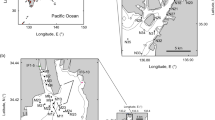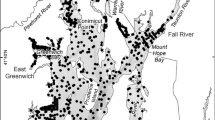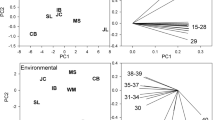Abstract
Although the identification of organisms to the levelof species is the ideal in studies of marinemacrobenthos, there are situations where such a finelevel of taxonomic discrimination may be eitherimpossible or unwarranted, for example when much thefauna is undescribed, or if the task for which samplesare collected does not require them to be identifiedto the species level. The idea that abundances ofhigher taxa, or particular groups of organisms, may beused as surrogates for the total fauna in such studiesis explored in this paper using data from theNorwegian sector of the North Sea. The generalconclusion is that, in surveys of soft sedimentmacrofauna in disturbed areas of the North Sea wherepollution imposes simple spatial gradients on thebenthic communities, little information aboutinter-sample relationships is lost using data based onfamily, polychaete species, or polychaete familyabundances, rather than species abundances. In morepristine areas where spatial patterns are determinedby a number of processes, correlations betweencalculated diversity indices and similarity in faunalpatterns between species and family abundances arestill very high, but less so for polychaete species orpolychaete family abundances. This suggests thatidentification to the level of family may besatisfactory in many routine monitoring surveys,andidentification of only the polychaetes, either to thelevel of species or family, may also be a possiblealternative if there are clear disturbance gradientsin the survey area. Polychaetes are of importance indisturbed areas because the group contains tolerantand intolerant species, and in undisturbed areasbecause within the taxon species have a greater rangeof trophic and reproductive strategies than withinother taxa. Ultimately it is the distribution ofspecies, their identities, and their interactions witheach other and with the environment, that are ofinterest. The use of surrogates is likely to be mostadvantageous if it is only the extent of pollutioneffects from a discrete source that matters, andspecies level baseline studies have already beencompleted.
Similar content being viewed by others
References
Belbin, L., 1993. Environmental representativeness – regional partitioning and reserve selection. Biol. Conserv. 66: 223–230.
Bray, J. R. & J. T. Curtis, 1957. An ordination of the upland forest communities of southern Wisconsin. Ecol. Monogr. 27: 325–349.
Clarke, K. R. & M. Ainsworth, 1993. A method for linking multivariate community structure to environmental variables. Mar. Ecol. Prog. Ser. 92: 205–209.
Clarke, K. R. & R. H. Green, 1988. Statistical design and analysis for a 'biological effects' study. Mar. Ecol. Prog. Ser. 46: 213–226.
Clarke, K. R. & R. M. Warwick, 1994. Change in Marine Communities: An Approach to Statistical Analysis and Interpretation. Plymouth Marine Laboratory, Plymouth. 141 pp.
Clarke, K. R. & R. M. Warwick, 1998. Quantifying structural redundancy in ecological communities. Oecologia 113: 278–289.
Ferraro, S. P. & F. A. Cole, 1995. Taxonomic level sufficient for assessing pollution impacts on the Southern California Bight macrobenthos – revisited. Environ. Toxicol. Chem. 14: 1031–1040.
Gaston, K. J. & P. H. Williams, 1993. Mapping the world's species – the highest taxon approach. Biodiv. Letters 1: 2–8.
Gray, J. S., M. M. Aschan, M. R. Carr, K. R. Clarke, R. H. Green, T. H. Pearson, R. Rosenberg & R. M. Warwick, 1988. Analysis of community attributes of the benthic macrofauna of Frierfjord/Langesundfjord and in a mesocosm experiment. Mar. Ecol. Prog. Ser. 46: 151–165.
Gray, J. S., 1997. Marine biodiversity: Patterns, threats and conservation needs. Biodiv. Conserv. 6: 153–175.
Howson, C. M., 1987. Species Directory to British Marine Fauna and Flora. Marine Conservation Society, Ross-on-Wye, Hereforshire. 471 pp.
Hughes, T. P., A. H. Baird, E. A. Dinsdale, N. A. Moltschaniwskyj, M. S. Pratchett, J. E. Tanner & B. L. Willis, 1999. Patterns of recruitment and abundance of corals along the Great Barrier Reef. Nature 397: 59–63.
Kruskal, J. B. & M. Wish, 1978. Multidimensional Scaling. Sage Publishers, Beverly Hills, California. 93 pp.
Legendre, P., 1993. Spatial autocorrelation: Trouble or new paradigm? Ecology 74: 1659–1673.
Legendre, P. & M. J. Fortin, 1989. Spatial pattern and ecological analysis. Vegetatio 80: 107–138.
Noss, R. F., 1990. Indicators for monitoring biodiversity: a hierarchical approach. Conserv. Biol. 4: 355–364.
Olsgard, F. & J. S. Gray, 1995. A comprehensive analysis of the effects of offshore oil and gas exploration and production on the benthic communities of the Norwegian continental shelf. Mar. Ecol. Prog. Ser. 122: 277–306.
Olsgard, F., P. J. Somerfield & M. R. Carr, 1997. Relationships between taxonomic resolution and data transformations in analyses of a macrobenthic community along an established pollution gradient. Mar. Ecol. Prog. Ser. 149: 173–181.
Olsgard, F., P. J. Somerfield & M. R. Carr, 1998. Relationships between taxonomic resolution, macrobenthic community patterns and disturbance. Mar. Ecol. Prog. Ser. 172: 25–36.
Pearson, T. H. & R. Rosenberg, 1978. Macrobenthic succession in relation to organic enrichment and pollution of the marine environment. Oceanogr. Mar. Biol. Ann. Rev. 16: 22–311.
Rosenberg, R., 1972. Benthic faunal recovery in a Swedish fjord following the closure of a sulphite pulp mill. Oikos 23: 92–108.
Shannon, C. E. & W. W. Weaver, 1963. The Mathematical Theory of Communication. University Illinois Press, Urbana. 117 pp.
Snelgrove, P. V. R., 1997. The importance of marine sediment biodiversity in ecosystem processes. Ambio 26: 578–583.
Somerfield, P. J. & K. R. Clarke, 1995. Taxonomic levels, in marine community studies, revisited. Mar. Ecol. Prog. Ser. 127: 113–119.
Somerfield, P. J., F. Olsgard & M. R. Carr, 1997. A further examination of two new taxonomic distinctness measures. Mar. Ecol. Prog. Ser. 154: 303–306.
Vanderklift, M. A., T. J. Ward & C. A. Jacoby, 1996. Effect of reducing taxonomic resolution on ordinations to detect pollution-induced gradients in macrobenthic infaunal assemblages. Mar. Ecol. Prog. Ser. 136: 137–145.
Warwick, R. M., 1988a. Effects on community structure of a pollutant gradient – summary. Mar. Ecol. Prog. Ser. 46: 207–211.
Warwick, R. M., 1988b. Analysis of community attributes of the macrobenthos of Frierfjord/Langesundfjord at taxonomic levels higher than species. Mar. Ecol. Prog. Ser. 46: 167–170.
Warwick, R. M., 1988c. The level of taxonomic discrimination required to detect pollution effects on marine benthic communities. Mar. Pollut. Bull. 6: 259–268.
Warwick, R. M., 1993. Environmental impact studies on marine communities: Pragmatical considerations. Aust. J. Ecol. 18: 63–80.
Warwick, R. M. & K. R. Clarke, 1993. Comparing the severity of disturbance: a meta-analysis of marine macrobenthic community data. Mar. Ecol. Prog. Ser. 92: 221–231.
Warwick, R. M. & K. R. Clarke, 1995. New 'biodiversity' measures reveal a decreases in taxonomic distinctness with increasing stress. Mar. Ecol. Prog. Ser. 129: 301–305.
Author information
Authors and Affiliations
Rights and permissions
About this article
Cite this article
Olsgard, F., Somerfield, P.J. Surrogates in marine benthic investigations ‐ which taxonomic unit to target?. Journal of Aquatic Ecosystem Stress and Recovery 7, 25–42 (2000). https://doi.org/10.1023/A:1009967313147
Issue Date:
DOI: https://doi.org/10.1023/A:1009967313147




